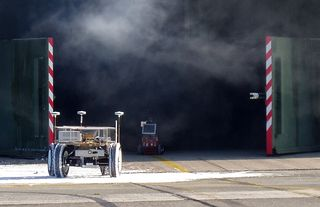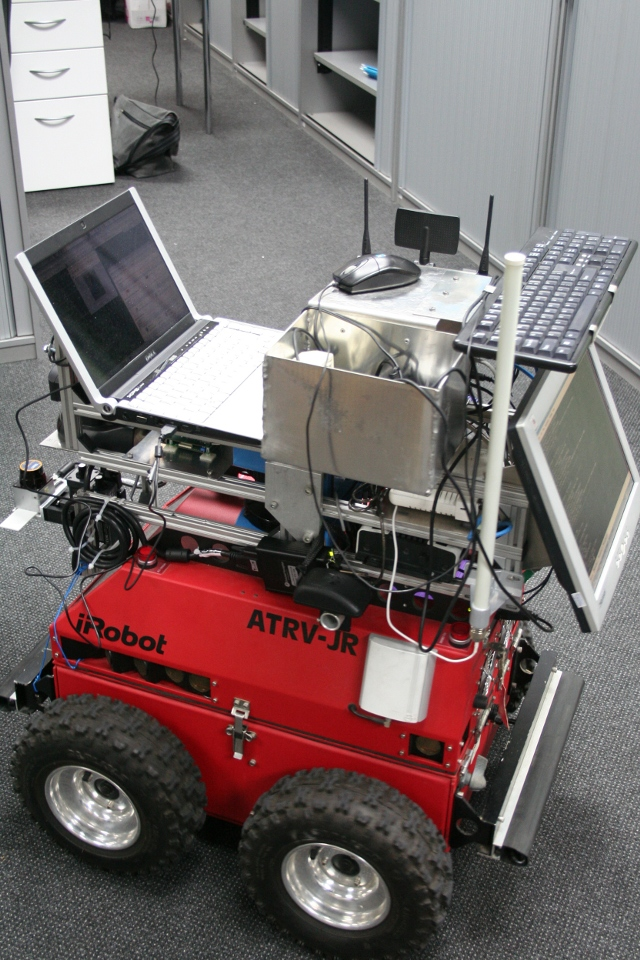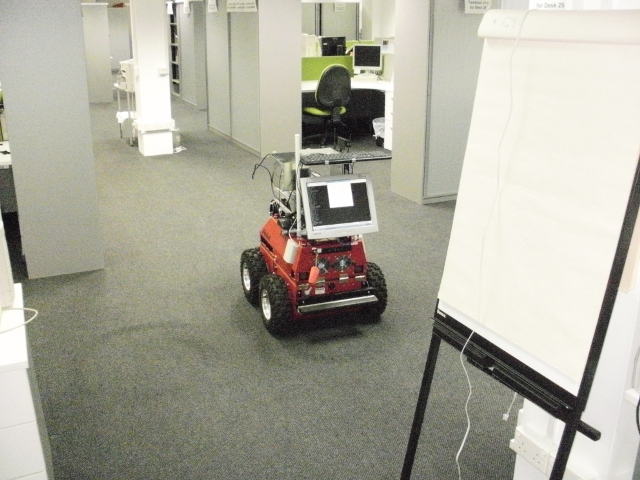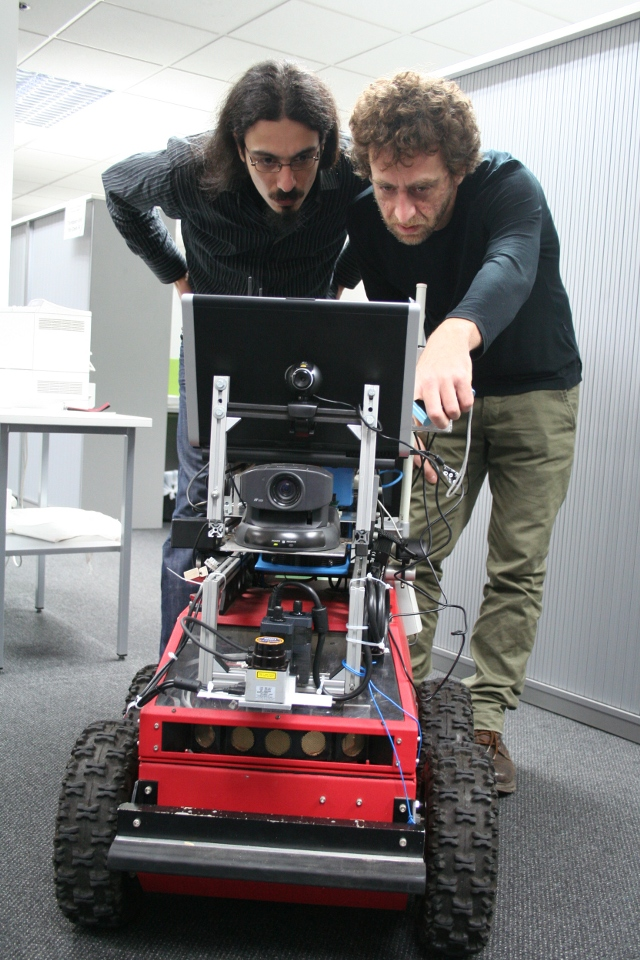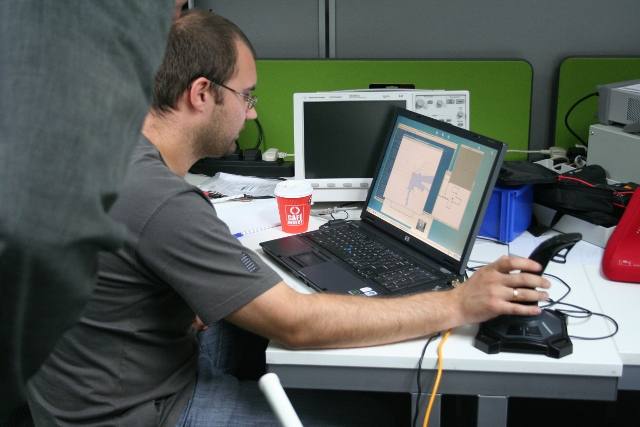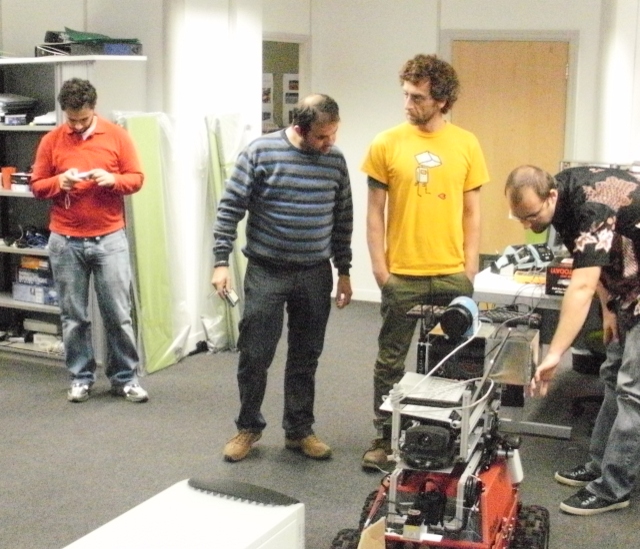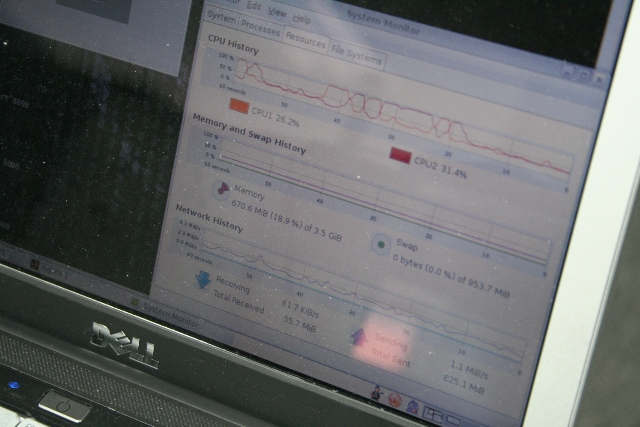VIEW-FINDER
Contents |
The VIEW-FINDER project
In the event of an emergency, due to a fire or other crisis, a necessary but time consuming pre-requisite, that could delay the real rescue operation, is to establish whether the ground can be entered safely by human emergency workers. The objective of the VIEW-FINDER project was to develop robots which have the primary task of gathering data to assist the human interveners in taking informed decisions prior to entering the area.
VIEW-FINDER was a field (mobile) robotics project (European-Union, Framework-VI: Project Number 045541), consisting of 9 European partners, that investigated the use of semi-autonomous mobile robot platforms to establish ground safety in the aftermath of fire incidents. The project was coordinated by the Materials and Engineering Research Institute at Sheffield Hallam University and officially ended on 30th November 2009, with final review, reports and demos scheduled for the 18 and 19 Jan. 2010.
The primary aim was to gather data (visual, environmental and chemical) to assist fire rescue personnel after a disaster has occured. A base station combined gathered information with information retrieved from the large scale GMES-information bases. Issues addressed, related to: 2.5D map building, localisation and reconstruction; interfacing local command information with external sources; autonomous robot navigation and human-robot interfaces (base-station). Partners PIAP, UoR, SHU and IES were pre-dominantly involved in the indoor scenario and RMA, DUTH predominately involved in the outdoor scenario; with SAS and SyFire being involved in both.
Notifications and Announcements
- Advisory: You are advised to visit the official VIEW-FINDER page: "Vision and Chemi-resistor Equipped Web-connected Finding Robots".
- Disclaimer: In this page you will be viewing pre-dominantly the indoor scenario even though we have tried for most of the information provided herein to be from the project as a whole. To the best of our knowledge the information provided herein are correct at the time of publication.
- Final dissemination event: IARP workshop RISE 2010 at Sheffield Hallam University on 20-21 January 2010. Further details available here.
System description
The developed VIEW-FINDER system was a semi-autonomous system; the individual robot-sensors operate autonomously within the limits of the task assigned to them. That is, they autonomously navigate from two assigned points by planning their path and avoid obstacles whilst inspecting the area. Henceforth, the remote central operations control unit assigns tasks to the robots and monitors their execution, with the ability to intervene at any given time. Inasmuch, central operations control has the means to renew task assignments or provide further details on tasks of the ground robot. System-human interactions at the central operations control were facilitated through multi modal interfaces, in which graphical displays play an important but not exclusive role.
 |
Although the robots have the ability to operate autonomously, human operators monitor the robots' processes and send high level task requests, as well as low level commands, through the human-computer interface to some nodes of the ground system. The human-computer interface (base station) had to ensure that a human supervisor and human intervener on the ground, are provided with a reduced yet relevant overview of the area under investigation including the robots and human rescue workers therein.
The project comprised of two scenarios: indoor and outdoor, with a corresponding robot platform for each scenario. The indoor scenario used a heavily modified ATRV junior robot platform that used to be available from iRobot and a purpose built outdoor robot based on the RoboSoft mobile platforms.
The indoor robot was equipped with two laser range finders, one of which was attached to a tilt unit for providing 3D acquisition, a front sonar array, a pan-tilt-zoom camera, a chemical sensor array and a long range wireless communication device. Apart from the existing robot processing unit (Ubuntu 8.04), there were added another two processing units (one with winXP and one with Ubuntu 8.10). The low level control of the robot and behaviour (e.g. obstacle avoidance and navigation) was achieved via the pre-existing processing unit whilst the data processing for the purposes of mapping and localisation were placed on the additional linux unit. The winXP unit was used whenever windows specific (proprietary) software items had to be deployed.
All robot collected data were forwarded to an ergonomically designed base station.
Project Partners
Coordinator
- SHU: Sheffield Hallam University, Materials and Engineering Research Institute (MERI, MMVL), Sheffield, United Kingdom
Academic Research Partners
- RMA: Royal Military Academy - Patrimony, Belgium
- DUTH: Democritus University of Thrace - Xanthi, Greece
- UoR: Sapienza University of Rome, Italy
- PIAP: Industrial Research Institute for Automation and Measurements, Poland
Industrial partners
- SAS: Space Applications Services, Belgium
- IES: Intelligence for Environment and Security SRL - IES Solutions SRL, Italy
- SyFire: South Yorkshire Fire and Rescue Service, United Kingdom
- GA: Galileo Avionica -S.P.A., Italy
Project outputs and dependencies
Selected Publications
- J. Bedkowski, and A. Maslowski (2009), An nVIDIA CUDA application in the Cognitive Supervision and Control of a mobile robot system. IARP/EURON Workshop in Robots for Risky Interventions and Environmental surveillance (Brussels, Belgium): 1-12
- A. Carbone, A. Finzi, A. Orlandini and F. Pirri (2008). Model-based control architecture for attentive robots in rescue scenarios. Autonomous Robots 24: 87-120
- L. Alboul, B. Amavasai, G. Chliveros and J. Penders (2007). Mobile robots for information gathering in a large-scale fire incident. IEEE 6th (SMC UK-RI) Conference on Cybernetic Systems (Dublin, Ireland): 122-127
Selected Public Reports
- coming soon
Software that has proven useful
- System architecture/integration
- Mapping and Localisation
See Also
- Project publicity (UK)
- Other projects
- Source of Inspiration and Robot platforms
- Journal of Field Robotics
- Earthquake Rescue Robots
- CHRYSOR
- PIAP Military INSPECTOR
- Mobile Robots Inc. Seekur Jr [1][2]
- Other related links
- NASA Three-Robot System for Traversing Steep Slopes
- BBC news: robotic firefighting
- Channel 4 News: Rise of the Machines?
- Robot mining trucks
- Robots can jump...
- DEFACTO fire-training software
- NIST Christmas tree fire video
- NIST's FDS-SMV fire dynamics simulator (also see comparison of real and simulated fire)
Videos and results
|
A prototype of the ViewFinder SLAM procedure based on an SIR-RB particle filter implementation: ladar and odometry data collected via the Player software platform.
|
A video demonstration of the base-station controlling the ATRV-Jr robot through the Human-Machine interface. Different views and control means are shown.
|
More to add here |
|
Nitrogen gas evolution in a room-fire scenario (simulated with NIST's FDS-SMV); a vertical and horizontal plane are only shown with the fire start indicated by a yellow patch.
|
Outdoor trials at the Royal Military Academy outdoor robot (RMA) and Base Station (SAS); a glimpse of the indoor ATRV-jr robot (PIAP) can also be seen.
|
X-addition |
| X-addition | X-addition | More to be added here |
